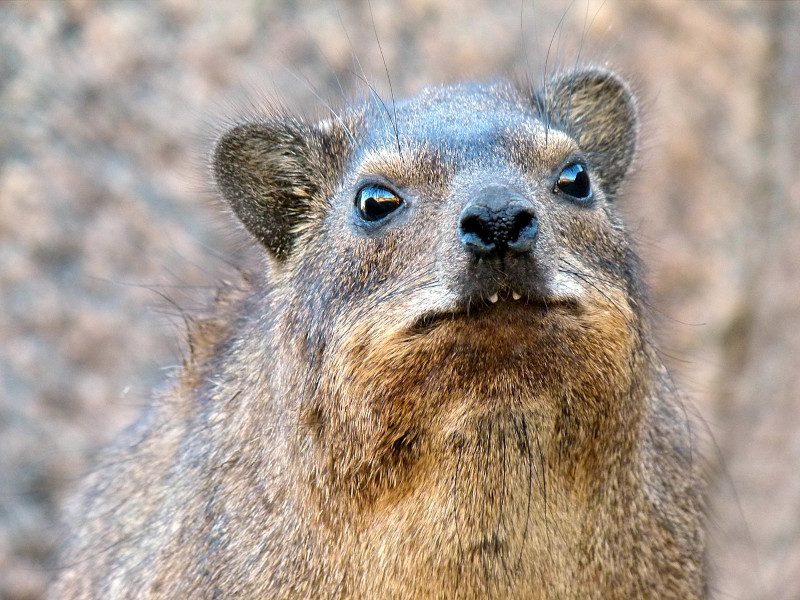
Rock Hyrax Facts
- The majority of peole know this intriguing small product of Nature and evolution by its informative common name of Rock Hyrax. Yet, the marvel also has other general titles by which it’s known. These include rock rabbit and Cape Hyrax, among others.
- Within the scientific community, however, it’s possibly generally better known by its technical label. Fortunately, that’s a comparatively simple one for the average layperson to pronounce. That’s true since it holds the formal moniker of Procavia capensis.
- The animal received that appellation due to the efforts of Peter Simon Pallas. The respected Prussian zoologist accomplished the first recognition of it as a separate and distinct species. He managed that scientifically noteworthy deed in the year 1766.
- It’s worthy of scientific note for several reasons. The remarkable creature represents one of only five surviving members of its Order. It also distinguishes itself further. Its genetics also serve to make this natural wonder the only member of its Genus.
- Thankfully, the amazing Rock Hyrax continues to maintain a population base that’s both stable and sufficient. This pleasant state further seems to hold true throughout the entirety of its range. The IUCN thus currently lists it as Least Concern on the Red List.
- But the creature should still be considered as facing potential threats to its continued existence as a species. Like all other forms of life on earth, most of these stem from the actions of man. They include the dual perils of habitat loss and climate change.
Related Articles
Rock Hyrax Physical Description
The interesting Rock Hyrax generally captures the attention of those individuals fortunate enough to encounter one. It typically does so, however, due more to its overall appearance than size. That’s due to the fact that the animal is only a moderate-sized animal.
Like a large percentage of mammals, it displays a certain degree of the physiological characteristic known as sexual dimorphism. In its case, this trait manifests itself in a somewhat different manner than many species. It’s one way in which the animal stands out.
Both sexes attain an average body length equaling approximately 20 in (50 cm). Males tend to reach roughly 8.8 lb (4 kg) in mass. The females, though, only achieve about 90% of this weight. This gives the males a slightly stockier build than their counterparts.
The amazing creature develops thick fur across the entirety of its body. This covering most commonly shows grayish-brown. Yet, it also varies due to different environments, sometimes greatly. Depending on this factor, it ranges in hue from light gray to dark brown.
Yet, it’s the general body structure of the Rock Hyrax that stands out the most. The head of the animal develops as pointed in nature. This itself sits atop a comparatively short neck. The small eyes and nose present as dark black. It also has small, roughly rounded ears.
Perhaps its most distinctive feature, though, lies in its mouth. The upper jaw holds two downward pointing tusk-like teeth. These vaguely resemble the tusks of an elephant, to which it’s actually distantly related! The bottom of the feet also have soft, thick pads.
- Kingdom: Animalia
- Phylum: Chordata
- Class: Mammalia
- Order: Hyracoidea
- Family: Procaviidae
- Genus: Procavia
- Species: P. capensis
Rock Hyrax Distribution, Habitat, and Ecology
The impressive Rock Hyrax evolved as native to a moderate section of the surface of the earth. The location of that zone of habitation likely won’t surprise many people, though. That’s because this marvel of Nature developed as endemic to the continent of Africa.
Yet, it also appears in parts of the Middle East. There, the animal lives in Lebanon, Israel, Jordan, and the Arabian Peninsula. In Africa, it has a disjointed population. It lives in the far northern and southern areas. It obviously must have once lived throughout the area, though.
The marvelous species displays clear preferences regarding its choice of habitat. This consists almost exclusively of arid, rocky, scrub-covered regions. The remarkable product of natural selection also displays a clear favoritism for areas filled with multiple rock crevices.
Yet, it does display a versatility and adaptability in terms of the altitudes at which it lives. Provided a region possesses the other attributes mentioned, it serves just as well. Groupings of the mammal therefore dwell at alttitudes of up to as much as 13,800 ft (4,200 m).
The Rock Hyrax further evolved as a highly social species. It generally lives in groupings, ranging in number from 10 – 80 individuals. As a general principle, these usually even forage as a coherent group. Active sentries even stand watch and warn of any danger.
It’s primarily carnivorous in terms of diet. Food sources consist of a wide variety of locally available plants. On occasion, though, this fare may be supplemented with grubs and insects. Its many predators include snakes, eagles, caracals, hawks, leopards, owls, and wild dogs.
Species Sharing Its Range
Check out our other articles on 4 Charming Christmas Season Species, Tree Bumblebee, Mount Jade, Serval, Coral Honeysuckle, Black-and-white hawk-eagle, Alligator Snapping Turtle
